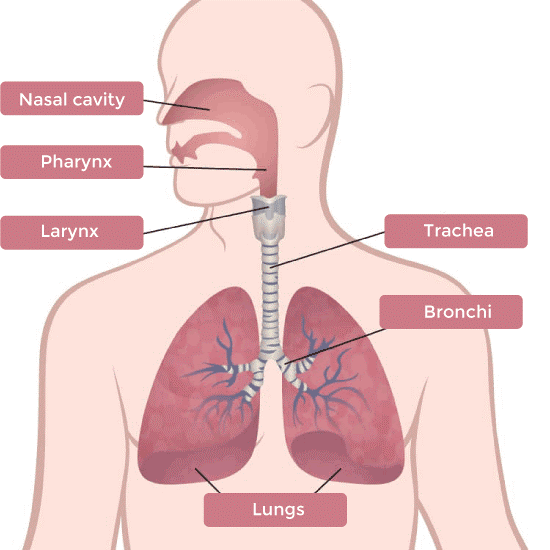Lungs DefinitionWhat do We Mean, Lungs?Our lungs make up a large part of our respiratory system in our body, which is the network of organs and tissues that allow us to take breathe. Every human has two lungs, one on each side of the chest, commonly known as the thorax. Our thorax is the area of our body which is located between our neck and our abdomen. 
Right LungThe superior, middle, and inferior lobes make up the three sections of the lung on our right side. It is usually shorter than our left lung, but wider than our left lung. Pleural tissue serves as a protective coating for both of our lungs. Left LungThe superior and inner lobes of our left lung are two distinct lobes. Our heart is located where the middle lobe of our left lung would be, thus it makes sense that our left lung is smaller than our right. Our right lung lacks the superior lobe extension known as the lingula and the cardiac notch that are both seen in our left lung. Our lungs provide our bodies with oxygen and remove other gases, such carbon dioxide, from them. 12 to 20 times every minute, this procedure occurs. When we inhale through our mouth or nose, air moves through our larynx (voice box), pharynx (back of the throat), and trachea (windpipe) before entering our trachea. Two bronchial tubes, or air passageways, divide our trachea. One bronchial tube serves our left lung, and the other serves our right lung. Our airways must remain open during both our inhalation and exhalation for our lungs to function at their peak. They must also be devoid of edoema, irritation, and excessive mucus production. Our bronchial tubes lead to the bronchi, which are much smaller airways, and ultimately into the bronchioles. The little air sacs at the end of the bronchioles, known as alveoli, are where oxygen is delivered from the air we breathe in to our blood. Alveoli resemble groups of tiny, rounded fruits. The blood exits our lungs after taking oxygen and travels to our heart. From there, it is pushed throughout our body to give our tissues and organs' cells oxygen. When cells use oxygen, carbon dioxide is produced and subsequently released into the circulation. Our bloodstream carries the carbon dioxide back to our lungs. To expel the carbon dioxide, we exhale. Tiny hairs in our nose act as an air-cleaning mechanism, helping to filter out large particles and protecting our respiratory system from harmful substances entering our lungs. Clean air passages are maintained by the sweeping motion of cilia, which are tiny hairs in our respiratory tract. Mucus is produced in our trachea and bronchial tubes to keep airways wet and help trap debris like dust and bacteria. Smoke from cigarettes is dangerous in part because it interferes with cilia's capacity to operate. Interesting Lungs-related InformationWe can live after having our lung lobes removed. Even surviving with just one lung is possible.
AnatomyWhere are our Lungs Located?Our lungs are located in our thorax, or chest. The region of our body that houses our lungs and other organs is known as our thoracic cavity. Lung support comes from a muscle called the diaphragm. What do Lungs Look Like?The colour of healthy lungs is pinkish-gray. We've probably seen images that contrast the lungs of smokers with those of non-smokers. Damaged lungs have a deeper grey colour and may have black patches. Our left and right lungs have triangular shapes that resemble elephant ears. When we're breathing regularly, a typical adult human lung weighs around 2.2 pounds and measures little over 9 inches. When our lungs are fully extended, it measures about 10.5 inches. Conditions and DisordersSome of Typical Ailments and Afflictions that Damage Our LungsLung disease can take many distinct forms. While some are minor or transient, others are chronic and more serious.
Some Most Common Signs or Symptoms of Lung ConditionsSome common signs and symptoms of lung conditions include:
Some Most Common Test to Check the Health of our LungsDuring a physical examination, our doctor or healthcare professional might determine specific things. They could:
In addition to a physical examination, our doctor may order several tests, including: Lung function testing, commonly referred to as a chest X-ray, computed tomography (CT) scan, ultrasound, and magnetic resonance imaging (MRI) scan. We should tell our doctor about the condition of our lungs. Some more tests are:
Procedures that May Require Sedatives or Anesthesia
What are Common Treatments for Lung Conditions?Our lung condition's true state and current state of health will determine how we are treated. Medication, exercise, medical equipment, and surgery are all examples of possible therapies. Medications may be offered as inhalers, nebulizer solutions, oral products or injections (shots).
Exercises and DevicesDiaphragmatic breathing, pursed lip breathing, and vest therapy are some examples of airway clearance techniques. These goods aid in clearing mucus from our airways. Surgeries
Care of Our LungWe can do a lot of things to maintain the health of our lungs or to assist treat lung diseases.
A Note from DoctorOur lungs can still become ill even though our respiratory system has mechanisms for protecting the body. Some illnesses are not dangerous and pass rapidly. There are some conditions that are more severe and persistent. Our normal healthcare practitioner might suggest seeing a pulmonologist if we suffer from a chronic lung condition. To breathe easily, it's crucial that we heed the advice of our medical staff.
Next TopicManufacturing Definition
|
 For Videos Join Our Youtube Channel: Join Now
For Videos Join Our Youtube Channel: Join Now
Feedback
- Send your Feedback to [email protected]
Help Others, Please Share










